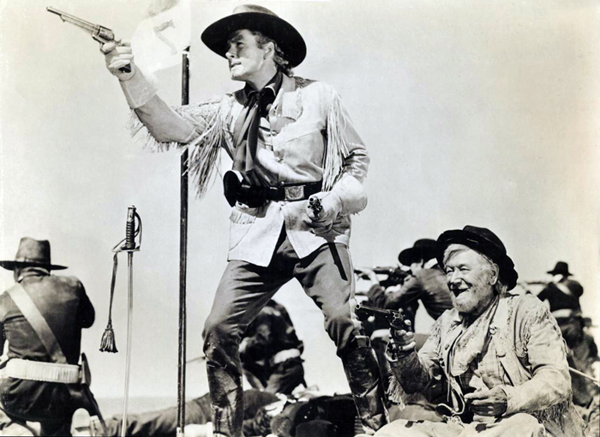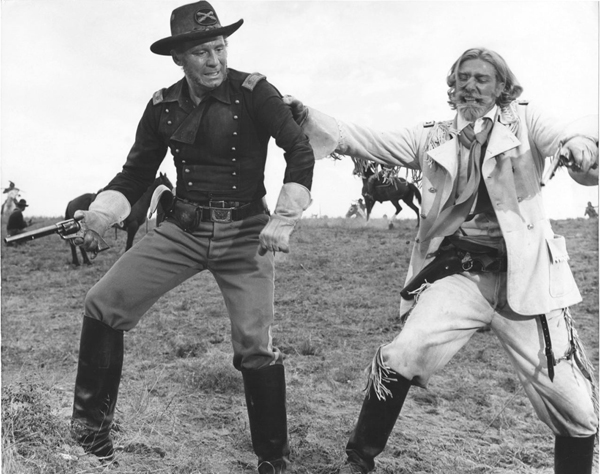Lt. Col. George Custer was once considered “the model of a Christian warrior.” In the 1870s, poets called him heroic, splendid and glorious. One magazine editor called him “chief among our nation’s knights,” and in popular opinion Custer was a martyr who fell defending the frontier.
How did a man so lauded by his contemporaries later become the subject of lasting ridicule and disgrace? In the Spring 2014 issue of Nebraska History, Brian W. Dippie discusses the factors involved in the changing image of George Armstrong Custer among historians and in popular culture.
Born in 1839, Custer became famous as the “Boy General” in the Civil War, and carried that fame with him when he joined the Seventh Cavalry after the war. But what ensured his lasting fame was his death. On an 1876 expedition to confine “hostile” Lakota to their reservation, Custer chose to attack an Indian camp that proved much larger than his forces. He and all 212 men under his direct command were killed at the Battle of Little Bighorn, or “Custer’s Last Stand.”
 Custer’s Last Stand, by F.C. Yohn, ca. 1929. From 1930 Calendar, Caron & McGrath (General Insurance), Southbridge, Massachusetts. In 1930, four years after the observance of the semi-centennial of his Last Stand, Custer was still riding high in popular esteem.
Custer’s Last Stand, by F.C. Yohn, ca. 1929. From 1930 Calendar, Caron & McGrath (General Insurance), Southbridge, Massachusetts. In 1930, four years after the observance of the semi-centennial of his Last Stand, Custer was still riding high in popular esteem.
On July 6, 1876, just two days after the United States’ 100th birthday, the nation received news of Custer’s defeat. Dippie explains how this timing was crucial – Custer’s defeat clashed with the centennial celebrations of American progress. Writers, poets and politicians romanticized Custer’s death, painting him as a hero to aspire to. As magazine editor E.M. Stannard wrote,
“Custer fell! But not until his manly worth had won for him imperishable honor. Pure as a virgin, frank and open-hearted as a child, opposed to the use of tobacco, liquors, and profane language, free from political corruption, cool and courageous in the midst of the fiercest battle, he has left to us the model of a Christian warrior.”
 They Died With Their Boots On (Warner Brothers, 1941). Errol Flynn’s grand finale in this film represents the zenith of Custer’s heroic career on the screen.
They Died With Their Boots On (Warner Brothers, 1941). Errol Flynn’s grand finale in this film represents the zenith of Custer’s heroic career on the screen.
Not everyone thought of Custer in such noble terms, but these dissenters were fairly quiet until the 1930s when criticism of Custer became more mainstream. The Great Depression made it hard to believe in glowing tales like the legend of Custer. In 1934, one year after Custer’s widow died, Frederic F. Van de Water published the biography Glory-Hunter, which portrayed Custer in an extremely unfavorable light. Van de Water saw Custer as a proud, immature and foolish man “with little to recommend him beyond a headlong bravery and a picturesque appearance. He’d have made a damned spectacular United States Senator, but he was a deplorable soldier.”
Perceptions of Custer were mixed for several decades. The 1941 movie They Died with Their Boots On once again portrayed a heroic, charismatic Custer and was released just days before the attack on Pearl Harbor. However by the 1960s, growing empathy for Native Americans and backlash from the Vietnam War caused Custer to be perceived more than ever as a foolish villain.
 Little Big Man (Cinema Center Films, 1970). Richard Mulligan’s Custer reversed the heroic conventions established in films like They Died With Their Boots On and served to critique American involvement in Vietnam by descent into madness at his Last Stand.
Little Big Man (Cinema Center Films, 1970). Richard Mulligan’s Custer reversed the heroic conventions established in films like They Died With Their Boots On and served to critique American involvement in Vietnam by descent into madness at his Last Stand.
Popular opinion has not seen Custer as a hero ever since. And in Dippie’s opinion, it probably never will again. “His champions have never given up – doomed Last Stands are in their blood – and they still fight a rearguard action in his defense,” Dippie writes. “But they have no purchase in popular culture. His detractors hold the field.”
– Joy Carey, Editorial Assistant, Publications




